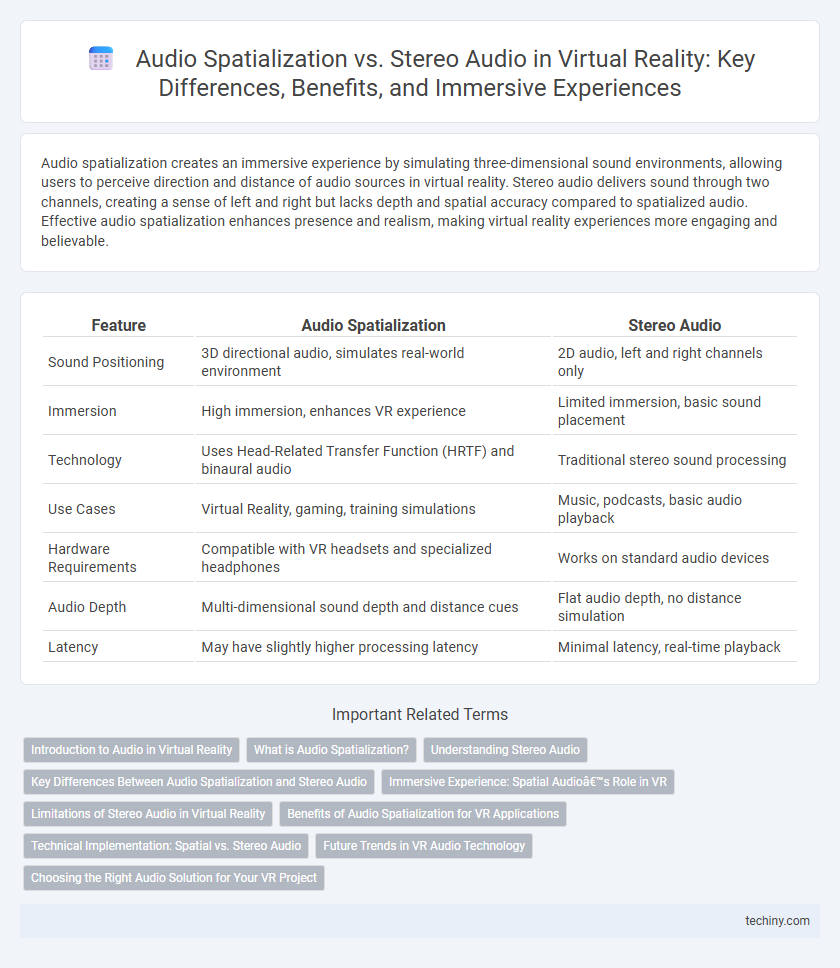Audio spatialization creates an immersive experience by simulating three-dimensional sound environments, allowing users to perceive direction and distance of audio sources in virtual reality. Stereo audio delivers sound through two channels, creating a sense of left and right but lacks depth and spatial accuracy compared to spatialized audio. Effective audio spatialization enhances presence and realism, making virtual reality experiences more engaging and believable.
Table of Comparison
| Feature | Audio Spatialization | Stereo Audio |
|---|---|---|
| Sound Positioning | 3D directional audio, simulates real-world environment | 2D audio, left and right channels only |
| Immersion | High immersion, enhances VR experience | Limited immersion, basic sound placement |
| Technology | Uses Head-Related Transfer Function (HRTF) and binaural audio | Traditional stereo sound processing |
| Use Cases | Virtual Reality, gaming, training simulations | Music, podcasts, basic audio playback |
| Hardware Requirements | Compatible with VR headsets and specialized headphones | Works on standard audio devices |
| Audio Depth | Multi-dimensional sound depth and distance cues | Flat audio depth, no distance simulation |
| Latency | May have slightly higher processing latency | Minimal latency, real-time playback |
Introduction to Audio in Virtual Reality
Audio spatialization in virtual reality creates a three-dimensional sound environment by simulating the direction and distance of sounds relative to the user's head position, enhancing immersion and realism. In contrast, stereo audio delivers sound through two channels, providing limited spatial cues primarily along the left-right axis. Implementing advanced audio spatialization techniques in VR is essential for accurately replicating real-world audio experiences, improving user orientation and presence within virtual environments.
What is Audio Spatialization?
Audio spatialization refers to the technology that creates a three-dimensional sound environment, enabling users to perceive the direction, distance, and movement of sounds within a virtual space. Unlike traditional stereo audio, which plays sound through two channels to create a left-right illusion, spatial audio simulates how sound waves interact with the head and ears, providing a more immersive and realistic audio experience in virtual reality. This technology enhances user presence by accurately replicating real-world acoustic cues in VR applications and games.
Understanding Stereo Audio
Stereo audio utilizes two distinct channels to create a sense of left and right sound positioning, enhancing depth and directionality compared to mono sound. This method relies on amplitude differences and slight timing variations between the channels to simulate spatial audio cues. While effective for basic sound localization, stereo audio lacks the immersive 3D sound field necessary for fully realistic virtual reality experiences.
Key Differences Between Audio Spatialization and Stereo Audio
Audio spatialization simulates 3D sound environments by accurately positioning audio sources in space, enhancing immersion in virtual reality experiences. In contrast, stereo audio delivers sound through two channels, creating a left-right audio field without depth or directional cues. The key difference lies in spatial audio's ability to reflect precise sound location and distance, offering a more realistic auditory experience compared to traditional stereo audio.
Immersive Experience: Spatial Audio’s Role in VR
Spatial audio enhances VR immersion by accurately replicating sound sources in a three-dimensional space, creating a realistic auditory environment that stereo audio cannot achieve. Unlike stereo, which delivers sound from two fixed channels, spatial audio simulates direction, distance, and movement of sounds, allowing users to perceive audio cues naturally within the virtual environment. This precise localization of sound significantly boosts presence and interaction, making virtual experiences more convincing and engaging.
Limitations of Stereo Audio in Virtual Reality
Stereo audio in virtual reality lacks precise spatial cues, limiting the ability to accurately localize sound sources within a 3D environment. This limitation reduces immersion and can cause disorientation, as stereo sound only provides left-right audio differentiation without depth or elevation information. Advanced audio spatialization techniques overcome these constraints by simulating realistic sound positioning, enhancing user presence and interaction in VR experiences.
Benefits of Audio Spatialization for VR Applications
Audio spatialization in VR applications enhances user immersion by accurately simulating sound sources in a three-dimensional environment, allowing precise localization and movement tracking of audio objects. Unlike stereo audio, which provides limited directional cues, spatialized audio adapts dynamically to head orientation and position, creating a realistic and engaging auditory experience. This technology significantly improves situational awareness, emotional impact, and overall presence in virtual reality scenarios.
Technical Implementation: Spatial vs. Stereo Audio
Spatial audio in virtual reality uses advanced algorithms and head-related transfer functions (HRTFs) to simulate sound coming from specific 3D locations, enhancing immersion through precise audio positioning. Stereo audio relies on two distinct channels to create a left-right sound field but lacks depth and vertical audio cues essential for realistic VR experiences. Implementing spatial audio requires complex signal processing and real-time tracking of user head movements, while stereo audio involves simpler mixing techniques with fixed sound source placement.
Future Trends in VR Audio Technology
Future trends in VR audio technology emphasize advanced audio spatialization techniques that create immersive soundscapes by accurately simulating sound sources in three-dimensional space. Unlike traditional stereo audio, spatial audio enhances user experience by providing directional audio cues, improving realism and situational awareness in virtual environments. Innovations leveraging machine learning algorithms and HRTF customization are poised to revolutionize VR audio, enabling personalized and adaptive audio rendering tailored to individual users.
Choosing the Right Audio Solution for Your VR Project
Audio spatialization enhances immersion in VR by accurately simulating sound direction and distance, creating a three-dimensional auditory environment that enriches user experience. Stereo audio, while simpler and less resource-intensive, offers basic left-right sound differentiation but lacks depth and precise localization crucial for VR realism. Selecting the right audio solution depends on project goals, hardware capabilities, and audience expectations, with spatial audio preferred for high-fidelity, interactive environments and stereo suitable for simpler or budget-conscious applications.
Audio Spatialization vs Stereo Audio Infographic

 techiny.com
techiny.com